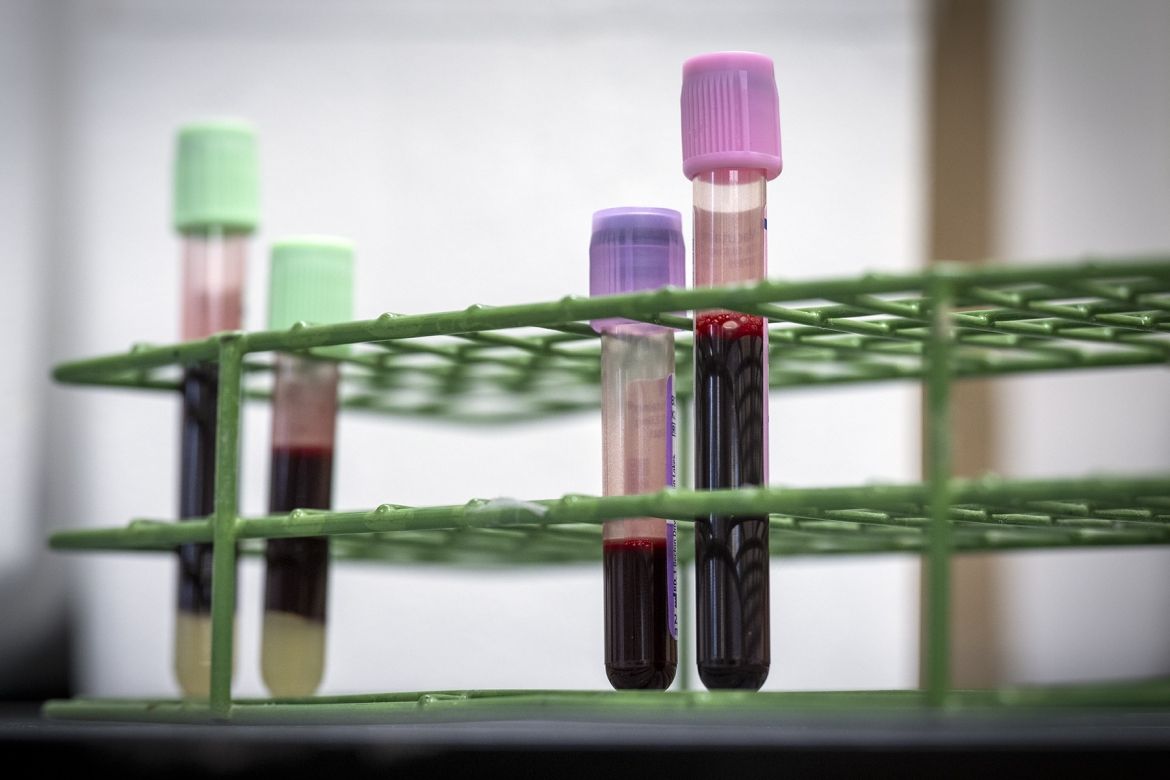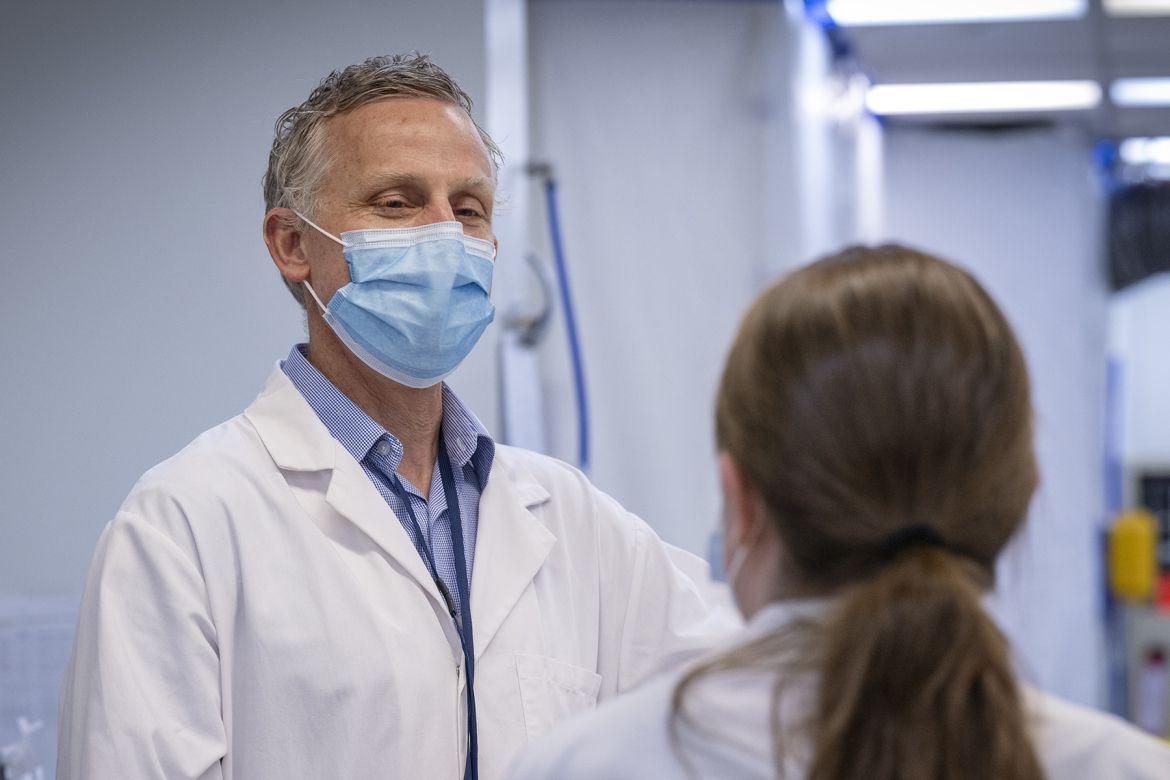Effective immediately masking is required for everyone when present on all inpatient units, in the Emergency Department (ED), the Urgent Care Centre (UCC), and the Children’s Outpatient Centre (COPC).

Blood is a precious, limited resource. Besides a transfusion, there’s no way to immediately replace it. That’s why Kingston Health Sciences Centre (KHSC) is one of the first hospitals in Canada to reduce the amount of blood it collects for testing, reducing hospital patient strain and demand on donated blood products.
Each day in hospital an average patient loses 22 milliliters of blood in the sample collection tubes used for laboratory testing. If a patient needs a very long hospital stay, this results in a lot of blood loss. So, blood tests create a challenging trade-off for patients. While bloodwork provides crucial information to help guide treatment, losing too much blood can increase the risk of anemia, a shortage of red blood cells, and blood transfusion.
To help, KHSC introduced a new approach to blood testing earlier this fall that reduces blood-loss from diagnostic testing. The idea is simple: replace standard blood test vials with smaller tubes that draw less blood. These tubes are routinely used for children in hospital, but have never been widely used in adults.
It sounds like a small change, but it’s having a big impact on patients.
Reducing patient strain
Standard sample tubes take around 3-6 milliliters of blood and, depending on the type or severity of illness, patients could need multiple vials taken several times a day. Only 10% of the blood drawn from patients is needed for testing, with 90% is discarded as medical waste.
A critically ill patient in the Intensive Care Unit (ICU), for example, could require three different tests, each requiring a separate tube and a total volume of 9 milliliters of blood to fill all three tubes. Additional factors, like cardiac symptoms, could require another test, bringing the total draw to four vials. Blood work could be done 2-3 times a day, and with three routine tests done each time, the total draw is around 27 milliliters of blood for testing alone.
“It starts to add up quickly, and it can create an unnecessary need for a blood transfusion, an avoidable risk for patients. Losing too much blood can slow recovery and cause complications like anemia. For patients who have lost a lot of blood for laboratory testing, it may also bring them closer to needing a transfusion, which we have to work hard to avoid.” - Dr. Jeannie Callum, Director of Transfusion Medicine for KHSC
The low-volume vials now in use look identical, but have less vacuum pressure and draw less blood. They take 1.8-3.0 milliliters (around half the amount of the previous, standard vials) but still have enough volume to do all the testing requested by clinicians.
A pilot study in KHSC’s ICU took place in May 2023 with expanded roll-out to the entire unit in June. The pilot was led by Dr. Christine D’Arsigny from Critical Care and Dr. Curtis Oleschuk from Clinical Chemistry. All areas, excluding the Emergency Department and Hotel Dieu Hospital, were transitioned to the new vials in July. By October, all units across all sites were transitioned to the new, low-volume blood tubes.
A Canadian study, published in the Journal of the American Medical Association in October, led by Canadian researcher, Dr. Deborah Siegal, found that small-volume blood collection tubes reduce the number of blood transfusions required in intensive care units. It showed that using low volume tubes for 100 patients in critical care would prevent 10 blood transfusions.
What is novel is that KHSC implemented these tubes for adults across the hospital admitted to surgery, medicine, or other areas of the hospital, not just in critical care.
Making the change
“Something like switching one vial for another sounds easy, but that sort of change takes lots of patience and persistence in a system this complex,” says Dr. Curtis Oleschuk, Clinical Biochemist with KHSC’s pathology and molecular medicine team, and one of the key staff involved in leading this important transition.
The chemistry unit alone performs approximately 1.5 million tests in a year, so the change needed to be compatible with current processes. In addition to guaranteeing that low-volume sample tubes could meet testing needs, they needed to be tested with KHSC’s laboratory robotics to ensure they were compatible with automated processes.
While there are no risks to patients with this new approach, the vials take slightly longer to fill and staff would need training. Buy-in and support from the phlebotomy team, responsible for bloodwork and nursing staff across the organization was critical. The phlebotomy team was the first to trial the tubes and they showed that the tubes could be implemented without impact on the blood collection process.
“It’s a testament to collaboration across the organization. We had a really nice partnership with the nurse education team, which was responsible for training staff. They were very supportive of this move and were a major asset. The Supply Management Team at KHSC also did an excellent job coordinating the transition in tube supply at each phase of the roll-out." - Dr. Oleschuk
In 2022, medical laboratories across Canada faced a shortage of sample collection tubes and, while the situation is back to normal, the Laboratory Team wanted to ensure that they could guarantee a consistent supply of the new tubes going forward.
“There was a previous supply shortage and we just wanted to make sure there wouldn’t be any impacts,” says Dr. Oleschuk. “Our vendor confirmed that they had a good supply. We had assurances at every level, so things could proceed.”
The new sample collection tubes are the same price as the standard tubes, meaning patient outcomes could also be improved without additional healthcare costs.
The big picture
In the right situation, a blood transfusion may be a patient’s only option when they develop anemia in hospital, but it is a complicated process that carries its own risks.
“A transfusion introduces new potential complications that could hinder rather than help a patient’s recovery. Blood transfusions have numerous risks including triggering heart failure and increasing the risks of infection. Taking less blood for routine testing is a simple way to reduce the risk of transfusion and other complications.” - Dr. Callum
Canadian Blood Services, the national blood operator responsible for ensuring patients in Canada have access to a reliable supply of blood products, has been challenged in recent months by unusual weather conditions that disrupted donation events, which meant distribution of blood products to hospitals was outpacing collections.
Blood products are needed for a dozens of treatment types including the routine management of severe illnesses, cancer treatments, cardiac surgery and care for patients with traumatic injuries like car accidents. The combination of an aging population needing more transfusions per capita, and more aggressive cancer treatments, has increased the demand for blood transfusion. Every unit of blood not transfused for anemia from blood sample collection makes it available for another patient in need.
KHSC is one of only a handful of hospitals in Canada to move to low-volume blood test tubes across the whole organization for all adult patients, but “small” interventions like this are becoming a necessity in this unprecedented environment. They’re helping to reduce the likelihood of a transfusion by drawing less blood for testing, saving those units of blood for a situation when it’s the only option.
As a transfusion champion, Dr. Callum has worked with Canadian Blood Services to spread the news about this new study and implementing smaller test tubes across Canada.
“It’s a win for everyone involved. Patients lose less blood and get fewer transfusions and nursing and blood bank staff have to transfuse fewer patients, saving time to dedicate to support other areas,” says Dr. Callum. She also hosted a “Breakthroughs in Blood” webinar where Dr. Oleschuk and a panel of other experts discussed how hospitals and clinics could navigate the change. The webinar, along with additional resources and tools, is provided by Canadian Blood Services to support practice change.
Donors are needed every week – even during the holidays – to ensure blood products are there for patients when they need them. Visit blood.ca, download the GiveBlood app, or call 1-888-2DONATE (1-888-236-6283) today to book an appointment to donate blood as soon as you can.
Gallery





The low-volume vials now in use look identical to standard vials but collect around half the amount of blood.

Clinical Biochemist with KHSC’s pathology and molecular medicine team



